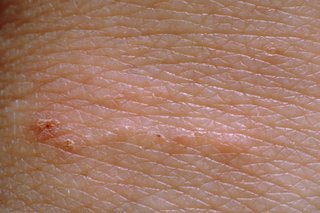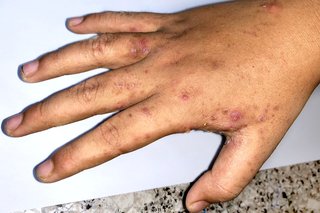Scabies is a skin condition caused by a tiny mite that gets under the skin and lays eggs.
It is:
- very common - anyone can get it
- passed by skin-to-skin or sexual contact with a person who has scabies
- easily spread - so it should be treated quickly
- not usually a serious condition - but it does need to be treated correctly
Check if you have scabies
The main symptom of scabies is intense itching, especially at night.
Later, you might also have a raised line on your skin with dots at each end. This is caused by the mites digging under your skin.
After time, it can look like a raised rash or spots. These may look red. They are more difficult to see on brown or black skin, but you should be able to feel them.
The raised line, rash or spots can appear anywhere on your body. But they are common around the hands, wrists, legs, bum, feet, penis or vagina.




It can take up to 6 weeks after the mites get under your skin for the scabies rash to appear.
It usually spreads across the whole body, but not the head.
You may develop a rash on your head and neck if you:
- are an older person
- are a very young child
- have a weakened immune system
Treatment for scabies
Your pharmacist can help with scabies.
They will recommend a cream or lotion. You can buy this without a prescription. You'll need to repeat the treatment 1 week later.
You usually apply the cream or lotion from your ears downwards. But children and the elderly can apply it over their whole body. Read the instructions carefully that come with the cream or lotion. Ask your pharmacist if you are unsure.
It's important that you also:
- follow advice on washing bedding and clothing to prevent the mites coming back
- stay at home for 24 hours after the first treatment has been applied. Do not have visitors. Avoid direct skin-to skin contact with others
Household and sexual contacts
Everyone in your house that you have close contact with needs to be treated at the same time - even if they do not have symptoms.
If you have had sexual contact with anyone in the past 6 weeks, they should also be treated.
Your household and sexual contacts will also need to repeat the treatment after 1 week.
They should also follow the same advice for washing their bedding and clothes, even if they do not have any symptoms
Help with itchiness
Calamine lotion, emollients or antihistamines may help to relieve itchy skin. Some of these are available without a prescription.
If you are very itchy, your GP can prescribe creams that help with itchiness.
How long it takes to get rid of scabies
You or your child can go back to work or school 24 hours after the first treatment.
Although the treatment kills the mites quickly, the itching can carry on for up to 4 weeks afterwards.
Non-urgent advice: Contact your GP if:
- your skin is red, sore or hot - these may be signs of a skin infection
- you feel unwell
- your rash is crusted or flaky
- your skin is still itching 4 weeks after treatment has finished
How to stop scabies spreading
Anyone can get scabies. It has nothing to do with poor hygiene. You cannot get scabies from pets.
People who live or work closely together in nurseries or nursing homes are more at risk.
Do
-
wash all bedding and clothing on the first day of treatment - 50 degrees Celsius will kill the mites
-
tumble dry bedding, towels and clothing at 50 degrees Celsius for at least 30 minutes if you cannot wash them
-
put clothing that cannot be washed in a sealed bag for 4 days until the mites die - this may include shoes, hats, soft toys and removable child car seat or buggy covers
-
vacuum any sofa or mattresses your skin has been in direct contact with for a long time
-
stop babies and children sucking treatment from their hands by putting socks or mittens on them
Don't
-
do not have sex or close physical contact with anyone until you have finished the full course of treatment
-
do not share bedding, clothing or towels with someone who has scabies
Complications of scabies
Scratching the rash can cause skin infections such as impetigo.
Scabies can make conditions such as eczema or psoriasis worse.
If there are a lot of mites under the skin, crusted scabies can form. This is serious, but not common. It can affect older people and those with a lowered immune system.
